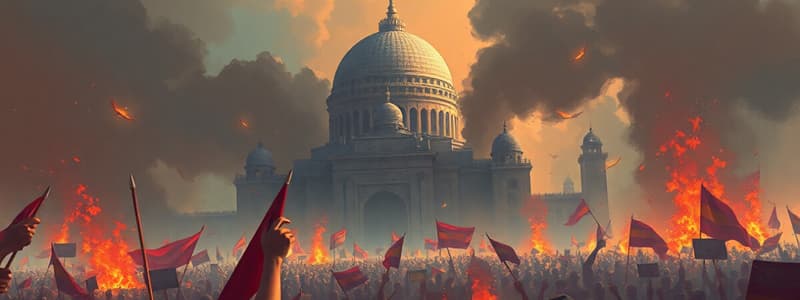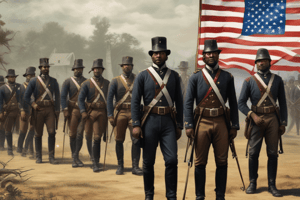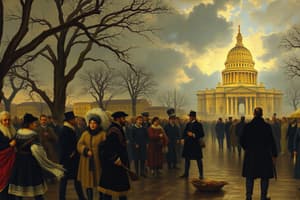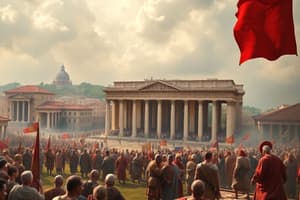Podcast
Questions and Answers
What factor can weaken mechanisms for conflict resolution, leading to increased violence?
What factor can weaken mechanisms for conflict resolution, leading to increased violence?
- Robust communication systems
- Strong community engagement
- High levels of education in society
- Lack of political trust (correct)
Which of the following is NOT a strategy to prevent potential civil unrest?
Which of the following is NOT a strategy to prevent potential civil unrest?
- Limiting public discussion to government officials (correct)
- Investment in education and employment
- Open dialogue and debate
- Inclusive policymaking
What makes predicting future civil unrest particularly challenging?
What makes predicting future civil unrest particularly challenging?
- Unforeseen circumstances like natural disasters (correct)
- Strong public trust in government
- Consistent public opinion on policy
- The stability of political institutions
Which of the following contributes to the escalation of conflict according to the provided content?
Which of the following contributes to the escalation of conflict according to the provided content?
What is a key measure for strengthening political stability?
What is a key measure for strengthening political stability?
What type of policies could significantly increase economic inequality?
What type of policies could significantly increase economic inequality?
Which policy could lead to increased civil unrest related to social and cultural issues?
Which policy could lead to increased civil unrest related to social and cultural issues?
What environmental policy could provoke backlash from affected groups?
What environmental policy could provoke backlash from affected groups?
Which factor can escalate into civil war related to political processes?
Which factor can escalate into civil war related to political processes?
What existing societal condition is likely to exacerbate potential conflict caused by extreme policies?
What existing societal condition is likely to exacerbate potential conflict caused by extreme policies?
Which of the following can be perceived as unjust and lead to widespread anger?
Which of the following can be perceived as unjust and lead to widespread anger?
What can trigger extreme reactions related to national security and foreign policy?
What can trigger extreme reactions related to national security and foreign policy?
What can lead to a breakdown in trust in government regarding political processes?
What can lead to a breakdown in trust in government regarding political processes?
Flashcards
Extreme economic inequality policies
Extreme economic inequality policies
Policies that significantly widen the gap between the rich and poor, such as regressive tax policies, deregulation benefiting wealthy groups, and lack of social safety nets.
Political distrust
Political distrust
Loss of faith in government institutions, making violence a potential solution to conflict.
Automation-driven job displacement
Automation-driven job displacement
Job losses due to automation without adequate retraining and support for workers.
Weapon access
Weapon access
Signup and view all the flashcards
Unforeseen events
Unforeseen events
Signup and view all the flashcards
Restrictive individual freedoms
Restrictive individual freedoms
Signup and view all the flashcards
Imposing a particular ideology
Imposing a particular ideology
Signup and view all the flashcards
Unpredictable reactions
Unpredictable reactions
Signup and view all the flashcards
Controversial gender/sexual orientation reforms
Controversial gender/sexual orientation reforms
Signup and view all the flashcards
Powerful actors
Powerful actors
Signup and view all the flashcards
Extreme environmental regulations
Extreme environmental regulations
Signup and view all the flashcards
Inclusive policymaking
Inclusive policymaking
Signup and view all the flashcards
Disproportionate voting/electoral changes
Disproportionate voting/electoral changes
Signup and view all the flashcards
Open dialogue
Open dialogue
Signup and view all the flashcards
Dispute resolution
Dispute resolution
Signup and view all the flashcards
Suppression of political participation
Suppression of political participation
Signup and view all the flashcards
Undemocratic power seizure attempts
Undemocratic power seizure attempts
Signup and view all the flashcards
Education & employment
Education & employment
Signup and view all the flashcards
Escalating international conflicts
Escalating international conflicts
Signup and view all the flashcards
Strengthening democracy
Strengthening democracy
Signup and view all the flashcards
Predicting conflict
Predicting conflict
Signup and view all the flashcards
Pre-existing societal divisions
Pre-existing societal divisions
Signup and view all the flashcards
Perceived injustice
Perceived injustice
Signup and view all the flashcards
Study Notes
Introduction
- Analysis of potential extreme policies in the year 2025 that could lead to civil unrest.
- Focus on policies that deeply divide societal groups and trigger violent reactions.
Potential Areas of Extreme Policy Conflict
- Economic Inequality:
- Policies dramatically increasing the gap between the rich and poor, potentially by implementing regressive tax policies or deregulating industries that benefit wealthier groups.
- Draconian measures to control or abolish social safety nets, leading to severe hardship for vulnerable populations.
- Automation-driven job displacement if proper retraining and support for affected workers are not prioritized.
- Social and Cultural Issues:
- Stricter laws restricting individual freedoms, such as in expression, religion, or assembly, potentially fueling opposition movements and protests.
- Policies promoting or imposing a particular ideology on the majority, creating cultural divisions and potentially leading to religious intolerance or suppression of dissenting viewpoints.
- Controversial reforms concerning gender identity or sexual orientation potentially leading to widespread protests and violence from opposing demographics.
- Environmental Policies:
- Extreme environmental regulations that disrupt industries and significantly affect livelihoods, provoking backlash from affected groups.
- Proposals focused on ecological protection causing mass displacement or affecting access to resources.
- Political Processes:
- Changes in voting procedures or electoral systems that disproportionately impact certain groups, possibly triggering widespread protests and defiance.
- Restriction on political participation, or suppression of opposition parties, leading to the complete breakdown in trust in government and democratic processes.
- Attempts to seize control of power through undemocratic means leading to outright rebellion.
- National Security and Foreign Policy:
- Escalating international conflicts or threats perceived by certain segments of society as endangering the nation and provoking extreme reactions.
Identifying Factors Contributing to Civil War
- Existing societal divisions: Pre-existing racial, ethnic, religious, or economic tensions provide a fertile ground for policies to exacerbate conflict.
- Perceived injustice: Policies perceived as unfairly targeting a specific group can ignite widespread anger and resentment.
- Lack of political trust: Erosion of faith in government institutions weakens mechanisms for conflict resolution, making violence appear as a viable option.
- Access to weapons and communication: Availability of weapons and high-speed communication can facilitate coordination and escalation of conflict.
Challenges in Predicting Future Events
- Unforeseen circumstances: External events (economic shocks, natural disasters, pandemics) can significantly alter the policy landscape.
- Unexpected reactions: Reactions to proposed policies often cannot be perfectly predicted, as public opinion and social movements are complex.
- Influence of powerful actors: The role of powerful political or economic groups or individuals in shaping policy-making process.
Preventing Potential Civil Unrest
- Inclusive policymaking: Policies that address the concerns of all segments of society.
- Open dialogue and debate: Fostering platforms for discussion and understanding across different viewpoints.
- Robust mechanisms for resolving disputes: Effective legal and political systems that allow for peaceful conflict resolution.
- Investment in education and employment: Policies that reduce socioeconomic inequality and increase opportunities.
- Strengthening democratic institutions: Promoting transparency, accountability, and integrity in government.
Concluding Remarks
- Assessing the likelihood of armed conflict in 2025 remains challenging due to numerous interacting variables.
- The potential for political volatility and extreme policies necessitates close monitoring of social and political trends, especially those based on inequality, injustice, political mistrust, and easy access to weapons.
Studying That Suits You
Use AI to generate personalized quizzes and flashcards to suit your learning preferences.




